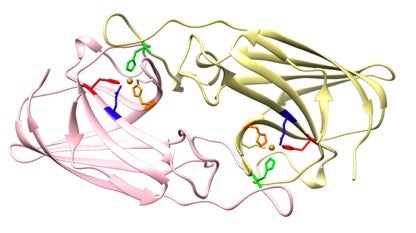ECU collaborators, students study pathogen that affects animals, humans
East Carolina University faculty members are collaborating on research that could eventually lead to development of a drug or vaccine to fight bacteria that can infect farm animals and people.
Dr. Sambuddha Banerjee, teaching assistant professor of chemistry at East Carolina University, is the primary investigator on newly published research in the Journal of Inorganic Biochemistry that examines strains of the Brucella pathogen, which can cause an infection known as brucellosis and leads to abortion and infertility in goats, sheep, swine and cattle. Humans coming in contact with these infected animals also can get brucellosis, causing a debilitating chronic illness.
“Currently, there are no vaccines available for human brucellosis and, therefore, is an important pathogen to study and treat,” Banerjee said.
“Investigating the roles of the conserved Cu2+-binding residues on Brucella FtrA in producing conformational stability and functionality” is a result of cross-collaborative research by Banerjee, ECU associate professor of chemistry Anne Spuches; biochemistry and chemistry undergraduate Mina Chanakira; former chemistry students Jacob Negron-Olivo and Yasmene Odeh; Brody School of Medicine researchers Ryan Garrigues, Martin Roop II, Joshua Pitzer, and Daniel Martin; and Saumya Dasgupta of Amity University, Kolkata, India.

Biochemistry and chemistry undergraduate Mina Chanakira is one of the student researchers on Dr. Sambuddha Banerjee’s newly published study pertaining to the Brucella pathogen.

Jacob Negron-Olivo, chemistry alumnus and quality control scientist at Thermo Fisher, gained valuable research experience at ECU that prepared him for his current career. (Contributed photos)

Yasmene Odeh, now a student in the Brody School of Medicine, said her experience performing research with Dr. Banerjee as a chemistry undergrad guided her on her path to medicine.
Spuches, who has collaborated with researchers at the Brody School of Medicine since coming to ECU in 2007, said the project with Banerjee is especially important to her because it is within her field of study, which seeks to understand metal ion interactions with proteins at the molecular level.
“It also showcases the truly collaborative nature of science as it brings together colleagues that have experience in the fields of inorganic chemistry, biochemistry and molecular biology,” she said. “I am especially thrilled that undergraduates in chemistry were introduced to this area of research.”
Chanakira, who will graduate in May 2021, said, “As a biochemistry student, research on the FtrA protein has given me hands-on experience and a deeper understanding of the material I have learned in my classes. Expressing and purifying proteins in the lab, reading and writing scientific papers, and presenting our research has made concepts such as buffer solutions and peptide bonds more relatable and accessible for me in class.”
“My experience as an undergraduate researcher with Dr. Banerjee helped me develop my work ethic and improve my critical thinking by analyzing experimental data and literature,” said Negron-Olivo, chemistry alumnus and current quality control scientist at Thermo Fisher Scientific. “I’m thankful for this opportunity, as it has helped me become a better scientist.”

A model of the Brucella FtraA protein when it has formed a Chain A and Chain B dimer. (Illustration courtesy of Banerjee)
According to Banerjee, Brucella infection in commercial farms in the U.S. has been contained, but it still poses considerable financial burden in free-ranging animals — for example in Yellowstone National Park — for farms in developing countries and upon human. People with brucellosis may develop flu-like symptoms that include fever, sweats, headaches, back pains and physical weakness. In severe cases, the central nervous system and the lining of the heart may be affected.
“Like most other pathogens, to survive and infect the host, Brucella steals its nutrients from the host. Iron is one such essential nutrient required by nearly all living organisms. The importance of iron uptake for the survival of Brucella is so pronounced that it has four distinct pathways performing this task,” Banerjee said.
In their study, Banerjee and his team used calorimetric, spectroscopic, and chromatographic methods showing that Brucella FtrA protein is effective only when it can form dimers (Chain A and B), and the stability of this functional dimer is dependent on the presence of certain amino acids on this protein, in particular, iron.
“Understanding the mechanism of action of this essential system is important for drug and vaccine development,” he said.
Odeh, a student in the Brody School of Medicine, said her experience performing research with Banerjee as a chemistry undergraduate “immensely guided me on my path to medicine. Being involved in research throughout my undergrad has now allowed me to better analyze current clinical studies and trials.”
In a separate project, another one of Banerjee’s undergraduate students is working in the lab to synthesize molecules that can be used to trick several drug-resistant bacteria, perhaps including Brucella. The bacteria think the drug is their food and take up the drug, which then may kill or render the bacteria ineffective, a technique of drug delivery known as the Trojan horse approach.